Cyanide Removal by ZnTiO3/TiO2/H2O2/UVB System: A Theoretical-Experimental Approach
Abstract
:1. Introduction
2. Results
2.1. Characterization of the Nanoparticles
2.1.1. XRD Analysis
2.1.2. SSA and pHPZC Analysis
2.1.3. SEM and EDS Analysis
2.2. Optimization of Cyanide Removal Process
2.3. Adsorption Studies
2.3.1. Effect of pH on Cyanide Adsorption
2.3.2. Maximum Cyanide Adsorption Capacity
2.3.3. Adsorption Thermodynamics
2.3.4. Kinetic of Cyanide Adsorption
2.3.5. DFT Study of the Cyanide Adsorption onto ZnTiO3/TiO2 Nanoparticles
2.4. Photodegradation Studies
2.5. Optimization of Process Variables and Reuse of Nanoparticles
2.6. Toxicity Studies
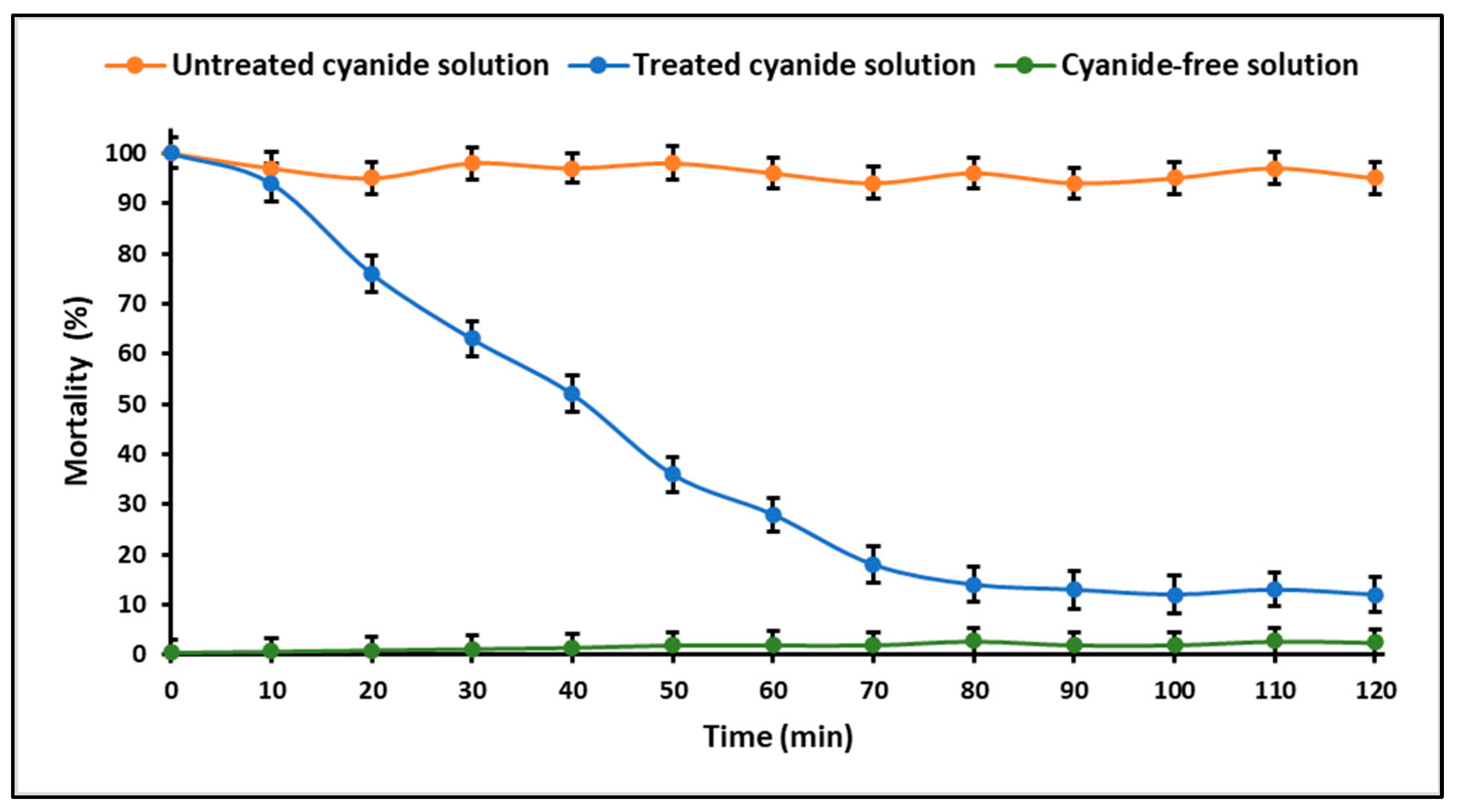
3. Discussion
3.1. Characterization of the Nanoparticles
3.1.1. XRD Analysis
3.1.2. SSA and pHPZC Analysis
3.1.3. SEM and EDS Analysis
3.2. Optimization of Cyanide Removal Process
3.3. Adsorption Studies
3.3.1. Effect of pH on Cyanide Adsorption
3.3.2. Maximum Cyanide Adsorption Capacity
3.3.3. Adsorption Thermodynamics
3.3.4. Kinetic of Cyanide Adsorption
3.3.5. DFT Study of the Cyanide Adsorption onto ZnTiO3/TiO2 Nanoparticles
3.4. Photodegradation Studies
3.5. Optimization of Process Variables and Reuse of Nanoparticles
3.6. Toxicity Studies
4. Materials and Methods
4.1. Materials
4.2. Synthesis of the ZnTiO3/TiO2 Nanoparticles
4.3. Characterization of the Nanoparticles
4.4. Adsorption Studies
4.4.1. Experimental Methodology
4.4.2. Theoretical Methodology
4.5. Photodegradation Studies
4.6. Reuse of Nanoparticles
4.7. Toxicity Studies
5. Conclusions
Supplementary Materials
Author Contributions
Funding
Institutional Review Board Statement
Informed Consent Statement
Data Availability Statement
Acknowledgments
Conflicts of Interest
References
- Anandan, S.; Kumar Ponnusamy, V.; Ashokkumar, M. A review on hybrid techniques for the degradation of organic pollutants in aqueous environment. Ultrason. Sonochem. 2020, 67, 105130. [Google Scholar] [CrossRef] [PubMed]
- Alvillo-Rivera, A.; Garrido-Hoyos, S.; Buitrón, G.; Thangarasu-Sarasvathi, P.; Rosano-Ortega, G. Biological treatment for the degradation of cyanide: A review. J. Mater. Res. Technol. 2021, 12, 1418–1433. [Google Scholar] [CrossRef]
- Pan, Y.; Zhang, Y.; Huang, Y.; Jia, Y.; Chen, L.; Cui, H. Synergistic effect of adsorptive photocatalytic oxidation and degradation mechanism of cyanides and Cu/Zn complexes over TiO2/ZSM-5 in real wastewater. J. Hazard. Mater. 2021, 416, 125802. [Google Scholar] [CrossRef]
- Maciel, A.C.; da Silva Pena, R.; do Nascimento, L.D.; de Oliveira, T.A.; Chagas-Junior, G.C.A.; Lopes, A.S. Health exposure risks and bioremediation of cyanide in cassava processing effluents: An overview. J. Water Process Eng. 2023, 55, 104079. [Google Scholar] [CrossRef]
- Betancourt-Buitrago, L.A.; Hernandez-Ramirez, A.; Colina-Marquez, J.A.; Bustillo-Lecompte, C.F.; Rehmann, L.; Machuca-Martinez, F. Recent Developments in the Photocatalytic Treatment of Cyanide Wastewater: An Approach to Remediation and Recovery of Metals. Processes 2019, 7, 225. [Google Scholar] [CrossRef]
- Biswas, P.; Bhunia, P.; Saha, P.; Sarkar, S.; Chandel, H.; De, S. In situ photodecyanation of steel industry wastewater in a pilot scale. Environ. Sci. Pollut. Res. 2020, 27, 33226–33233. [Google Scholar] [CrossRef]
- Zhang, Y.; Zhang, Y.; Huang, Y.; Chen, X.; Cui, H.; Wang, M. Enhanced photocatalytic reaction and mechanism for treating cyanide-containing wastewater by silicon-based nano-titania. Hydrometallurgy 2020, 198, 105512. [Google Scholar] [CrossRef]
- Han, W.; Yang, H.; Tong, L. Cyanide removal for ultrafine gold cyanide residues by chemical oxidation methods. Trans. Nonferrous Met. Soc. China 2022, 32, 4129–4138. [Google Scholar] [CrossRef]
- Wei, Y.; Chen, L.; Jiao, G.; Wen, Y.; Liao, Q.; Zhou, H.; Tang, S. Enhanced removal of metal-cyanide complexes from wastewater by Fe-impregnated biochar: Adsorption performance and removal mechanism. Chemosphere 2023, 331, 138719. [Google Scholar] [CrossRef]
- Yagmur Goren, A.; Recepoglu, Y.K.; Yoon, Y.; Khataee, A. Insights into sustainability of engineered carbonaceous material-based technologies for advanced cyanide removal from wastewater. Alex. Eng. J. 2023, 73, 69–88. [Google Scholar] [CrossRef]
- Kundu, A.; Cherwoo, L.; Kumar, B. Leveraging microorganisms for phenol and cyanide degradation in coke oven industry effluent treatment: Current advances and future potential. Bioresour. Technol. Reports 2023, 23, 101586. [Google Scholar] [CrossRef]
- Kim, T.K.; Kim, T.; Jo, A.; Park, S.; Choi, K.; Zoh, K.D. Degradation mechanism of cyanide in water using a UV-LED/H2O2/Cu2+ system. Chemosphere 2018, 208, 441–449. [Google Scholar] [CrossRef] [PubMed]
- Zmirli, Z.; Driouich, A.; El Harfaoui, S.; Mohssine, A.; Chaair, H.; Sallek, B. Cyanide effluent treatment by electrocoagulation using airlift reactor: Modeling and optimization by response surface methodology. Sci. Afr. 2023, 21, e01825. [Google Scholar] [CrossRef]
- Thaweewong, P.; Chotineeranat, S.; Anuntagool, J. Removal of free cyanide in dry-milled cassava flour using atmospheric nonthermal plasma treatment. LWT 2023, 181, 114761. [Google Scholar] [CrossRef]
- Pan, Y.; Zhang, Y.; Huang, Y.; Jia, Y.; Chen, L.; Cui, H. Functional Ag-doped coralloid titanosilicate zeolite (CTS-Ag) for efficiently catalytic and photodegradative removal of free cyanides and copper/zinc-cyanide complexes in real wastewater. J. Alloys Compd. 2022, 926, 166848. [Google Scholar] [CrossRef]
- Dong, K.; Xie, F.; Wang, W.; Chang, Y.; Lu, D.; Gu, X.; Chen, C. The detoxification and utilization of cyanide tailings: A critical review. J. Clean. Prod. 2021, 302, 126946. [Google Scholar] [CrossRef]
- Eletta, O.A.A.; Ajayi, O.A.; Ogunleye, O.O.; Akpan, I.C. Adsorption of cyanide from aqueous solution using calcinated eggshells: Equilibrium and optimisation studies. J. Environ. Chem. Eng. 2016, 4, 1367–1375. [Google Scholar] [CrossRef]
- Núñez-Salas, R.E.; Hernández-Ramírez, A.; Hinojosa-Reyes, L.; Guzmán-Mar, J.L.; Villanueva-Rodríguez, M.; de Lourdes Maya-Treviño, M. Cyanide degradation in aqueous solution by heterogeneous photocatalysis using boron-doped zinc oxide. Catal. Today 2019, 328, 202–209. [Google Scholar] [CrossRef]
- Chen, X.; Ren, Y.; Qu, G.; Wang, Z.; Yang, Y.; Ning, P. A review of environmental functional materials for cyanide removal by adsorption and catalysis. Inorg. Chem. Commun. 2023, 157, 111298. [Google Scholar] [CrossRef]
- Maulana, I.; Takahashi, F. Cyanide removal study by raw and iron-modified synthetic zeolites in batch adsorption experiments. J. Water Process Eng. 2018, 22, 80–86. [Google Scholar] [CrossRef]
- Boczkaj, G.; Fernandes, A. Wastewater treatment by means of advanced oxidation processes at basic pH conditions: A review. Chem. Eng. J. 2017, 320, 608–633. [Google Scholar] [CrossRef]
- Singh, S.; Kumar, V.; Datta, S.; Dhanjal, D.S.; Sharma, K.; Samuel, J.; Singh, J. Current advancement and future prospect of biosorbents for bioremediation. Sci. Total Environ. 2020, 709, 135895. [Google Scholar] [CrossRef] [PubMed]
- Lincho, J.; Zaleska-Medynska, A.; Martins, R.C.; Gomes, J. Nanostructured photocatalysts for the abatement of contaminants by photocatalysis and photocatalytic ozonation: An overview. Sci. Total Environ. 2022, 837, 155776. [Google Scholar] [CrossRef] [PubMed]
- Liu, Q.; Wu, Z.; Sun, Z.; Wang, Q.; Shi, J. Enhanced natural degradation of cyanide tailings: Integrated application of solar drying system and UV irradiation. J. Hazard. Mater. 2023, 458, 131871. [Google Scholar] [CrossRef]
- Ma, Y.; Sun, H.; Wang, Q.; Sun, L.; Liu, Z.; Xie, Y.; Zhang, Q.; Su, C.; Fan, D. Driving hydrogen peroxide artificial photosynthesis and utilization for emerging contaminants removal by cyanided polymeric carbon nitride. Appl. Catal. B Environ. 2023, 335, 122878. [Google Scholar] [CrossRef]
- Chuaicham, C.; Karthikeyan, S.; Song, J.T.; Ishihara, T.; Ohtani, B.; Sasaki, K. Importance of ZnTiO3 Phase in ZnTi-Mixed Metal Oxide Photocatalysts Derived from Layered Double Hydroxide. ACS Appl. Mater. Interfaces 2020, 12, 9169–9180. [Google Scholar] [CrossRef]
- Zhang, L.; Djellabi, R.; Su, P.; Wang, Y.; Zhao, J. Through converting the surface complex on TiO2 nanorods to generate superoxide and singlet oxygen to remove CN−. J. Environ. Sci. 2023, 124, 300–309. [Google Scholar] [CrossRef] [PubMed]
- Coronel, S.; Endara, D.; Lozada, A.B.; Manangón-Perugachi, L.E.; de la Torre, E. Photocatalytic study of cyanide oxidation using titanium dioxide (TiO2)-activated carbon composites in a continuous flow photo-reactor. Catalysts 2021, 11, 924. [Google Scholar] [CrossRef]
- Sánchez-Tovar, R.; Blasco-Tamarit, E.; Fernández-Domene, R.M.; Villanueva-Pascual, M.; García-Antón, J. Electrochemical formation of novel TiO2-ZnO hybrid nanostructures for photoelectrochemical water splitting applications. Surf. Coat. Technol. 2020, 388, 125605. [Google Scholar] [CrossRef]
- Al-Mamun, M.R.; Kader, S.; Islam, M.S.; Khan, M.Z.H. Photocatalytic activity improvement and application of UV-TiO2 photocatalysis in textile wastewater treatment: A review. J. Environ. Chem. Eng. 2019, 7, 103248. [Google Scholar] [CrossRef]
- Kanakaraju, D.; Chandrasekaran, A. Recent advances in TiO2/ZnS-based binary and ternary photocatalysts for the degradation of organic pollutants. Sci. Total Environ. 2023, 868, 161525. [Google Scholar] [CrossRef]
- Dubsok, A.; Khamdahsag, P.; Kittipongvises, S. Life cycle environmental impact assessment of cyanate removal in mine tailings wastewater by nano-TiO2/FeCl3 photocatalysis. J. Clean. Prod. 2022, 366, 132928. [Google Scholar] [CrossRef]
- Suhan, M.B.K.; Al-Mamun, M.R.; Farzana, N.; Aishee, S.M.; Islam, M.S.; Marwani, H.M.; Hasan, M.M.; Asiri, A.M.; Rahman, M.M.; Islam, A.; et al. Sustainable pollutant removal and wastewater remediation using TiO2-based nanocomposites: A critical review. Nano-Struct. Nano-Objects 2023, 36, 101050. [Google Scholar] [CrossRef]
- Lin, L.; Yang, Y.; Men, L.; Wang, X.; He, D.; Chai, Y.; Zhao, B.; Ghoshroy, S.; Tang, Q. A highly efficient TiO2@ZnO n-p-n heterojunction nanorod photocatalyst. Nanoscale 2013, 5, 588–593. [Google Scholar] [CrossRef] [PubMed]
- Fu, R.; Wang, Q.; Gao, S.; Wang, Z.; Huang, B.; Dai, Y.; Lu, J. Effect of different processes and Ti/Zn molar ratios on the structure, morphology, and enhanced photoelectrochemical and photocatalytic performance of Ti3+ self-doped titanium-zinc hybrid oxides. J. Power Sources 2015, 285, 449–459. [Google Scholar] [CrossRef]
- Pengkalsinan, K.; Tio, Z.; Melalui, F. Effect of calcination temperature on ZnO/TiO2 composite in photocatalytic treatment of phenol under visible light. Malays. J. Anal. Sci. 2017, 21, 173–181. [Google Scholar]
- Delsouz Khaki, M.R.; Shafeeyan, M.S.; Raman, A.A.A.; Daud, W.M.A.W. Enhanced UV–Visible photocatalytic activity of Cu-doped ZnO/TiO2 nanoparticles. J. Mater. Sci. Mater. Electron. 2018, 29, 5480–5495. [Google Scholar] [CrossRef]
- Khang, K.C.L.; Hatta, M.H.M.; Lee, S.L.; Yuliati, L. Photocatalytic removal of phenol over mesoporous ZnO/TiO2 composites. J. Teknol. 2018, 2, 153–160. [Google Scholar] [CrossRef]
- Chorf, H.; Saadoun, M.; Bousselmi, L.; Bessais, B.; Chorfi, H.; Saadoun, M.; Bousselmi, L.; Bessais, B. TiO2-ITO and TiO2-ZnO nanocomposites: Application on water treatment. In EPJ Web of Conferences; EDP Sciences: Les Ulis, France, 2012; Volume 29, p. 00015. [Google Scholar]
- Stefańska, K.S.; Kubiaka, A.; Piasecki, A.; Goscianska, J.; Nowaczyk, G.; Jurga, S.; Jesionowski, T. TiO2-ZnO Binary Oxide Systems: Comprehensive Characterization and Tests of Photocatalytic Activity. Materials 2018, 11, 841. [Google Scholar] [CrossRef]
- Jaramillo-Fierro, X.; González, S.; Montesdeoca-Mendoza, F.; Medina, F. Structuring of ZnTiO3/TiO2 adsorbents for the removal of methylene blue, using zeolite precursor clays as natural additives. Nanomaterials 2021, 11, 898. [Google Scholar] [CrossRef]
- Jaramillo-Fierro, X.; Alvarado, H.; Montesdeoca, F.; Valarezo, E. Faujasite-Type Zeolite Obtained from Ecuadorian Clay as a Support of ZnTiO3/TiO2 NPs for Cyanide Removal in Aqueous Solutions. Int. J. Mol. Sci. 2023, 24, 9281. [Google Scholar] [CrossRef] [PubMed]
- Cosmos, A.; Erdenekhuyag, B.O.; Yao, G.; Li, H.; Zhao, J.; Laijun, W.; Lyu, X. Principles and methods of bio detoxification of cyanide contaminants. J. Mater. Cycles Waste Manag. 2020, 22, 939–954. [Google Scholar] [CrossRef]
- Ke, S.; Cheng, X.; Wang, Q.; Wang, Y.; Pan, Z. Preparation of a photocatalytic TiO2/ZnTiO3 coating on glazed ceramic tiles. Ceram. Int. 2014, 40, 8891–8895. [Google Scholar] [CrossRef]
- Ramgir, N.; Bhusari, R.; Rawat, N.S.; Patil, S.J.; Debnath, A.K.; Gadkari, S.C.; Muthe, K.P. TiO2/ZnO heterostructure nanowire based NO2 sensor. Mater. Sci. Semicond. Process. 2020, 106, 104770. [Google Scholar] [CrossRef]
- Gnanaseelan, N.; Latha, M.; Mantilla, A.; Sathish-Kumar, K.; Caballero-Briones, F. The role of redox states and junctions in photocatalytic hydrogen generation of MoS2-TiO2-rGO and CeO2-Ce2Ti3O8.7-TiO2-rGO composites. Mater. Sci. Semicond. Process. 2020, 118, 105185. [Google Scholar] [CrossRef]
- Amaro-Medina, B.M.; Martinez-Luevanos, A.; de Jesus Soria-Aguilar, M.; Sanchez-Castillo, M.A.; Estrada-Flores, S.; Carrillo-Pedroza, F.R. Efficiency of Adsorption and Photodegradation of Composite TiO2/Fe2O3 and Industrial Wastes in Cyanide Removal. Water 2022, 14, 3502. [Google Scholar] [CrossRef]
- Stavropoulos, G.G.; Skodras, G.S.; Papadimitriou, K.G. Effect of solution chemistry on cyanide adsorption in activated carbon. Appl. Therm. Eng. 2015, 74, 182–185. [Google Scholar] [CrossRef]
- Muthirulan, P.; Nirmala Devi, C.; Meenakshi Sundaram, M. Synchronous role of coupled adsorption and photocatalytic degradation on CAC–TiO2 composite generating excellent mineralization of alizarin cyanine green dye in aqueous solution. Arab. J. Chem. 2017, 10, S1477–S1483. [Google Scholar] [CrossRef]
- Holzwarth, U.; Gibson, N. The Scherrer equation versus the “Debye-Scherrer equation”. Nat. Nanotechnol. 2011, 6, 534. [Google Scholar] [CrossRef]
- Kosmulski, M. The pH dependent surface charging and points of zero charge. VII. Update. Adv. Colloid Interface Sci. 2018, 251, 115–138. [Google Scholar] [CrossRef]
- Ramakrishnan, V.M.; Natarajan, M.; Santhanam, A.; Asokan, V.; Velauthapillai, D. Size controlled synthesis of TiO2 nanoparticles by modified solvothermal method towards effective photo catalytic and photovoltaic applications. Mater. Res. Bull. 2018, 97, 351–360. [Google Scholar] [CrossRef]
- Rueden, C.T.; Schindelin, J.; Hiner, M.C.; DeZonia, B.E.; Walter, A.E.; Arena, E.T.; Eliceiri, K.W. ImageJ2: ImageJ for the next generation of scientific image data. BMC Bioinform. 2017, 18, 529. [Google Scholar] [CrossRef] [PubMed]
- Schneider, C.A.; Rasband, W.S.; Eliceiri, K.W. NIH Image to ImageJ: 25 years of image analysis. Nat. Methods 2012, 9, 671–675. [Google Scholar] [CrossRef] [PubMed]
- Vorontsov, A.V.; Tsybulya, S.V. Influence of Nanoparticles Size on XRD Patterns for Small Monodisperse Nanoparticles of CuO and TiO2 Anatase. Ind. Eng. Chem. Res. 2018, 57, 2526–2536. [Google Scholar] [CrossRef]
- Aliprandini, P.; Botelho, A.B.; Veiga, M.M.; Marshall, B.G.; Scarazzato, T.; Espinosa, D.C.R. Evaluation of biosorbents as an alternative for mercury cyanide removal from aqueous solution. Miner. Eng. 2023, 204, 108431. [Google Scholar] [CrossRef]
- Jaramillo-Fierro, X.; Capa, L.F.; Medina, F.; González, S. Dft study of methylene blue adsorption on ZnTiO3 and TiO2 surfaces (101). Molecules 2021, 26, 3780. [Google Scholar] [CrossRef]
- Lin, C.S.; Zhou, A.Y.; Cheng, W.D.; Ye, N.; Chai, G.L. Atom-Resolved Analysis of Birefringence of Nonlinear Optical Crystals by Bader Charge Integration. J. Phys. Chem. C 2019, 123, 31183–31189. [Google Scholar] [CrossRef]
- Kumar, P.S.V.; Raghavendra, V.; Subramanian, V. Bader’s Theory of Atoms in Molecules (AIM) and its Applications to Chemical Bonding. J. Chem. Sci. 2016, 128, 1527–1536. [Google Scholar] [CrossRef]
- Zhang, H.; Huang, W.; Wang, W.C.; Shi, X.Q. Ionicity of bonding in elemental solids. J. Phys. Commun. 2018, 2, 115009. [Google Scholar] [CrossRef]
- Jaramillo-Fierro, X.; Gaona, S.; Valarezo, E. La3+’s Effect on the Surface (101) of Anatase for Methylene Blue Dye Removal, a DFT Study. Molecules 2022, 27, 6370. [Google Scholar] [CrossRef]
- Jaramillo-Fierro, X.; Cuenca, G.; Ramón, J. The Effect of La3+ on the Methylene Blue Dye Removal Capacity of the La/ZnTiO3 Photocatalyst, a DFT Study. Nanomaterials 2022, 12, 3137. [Google Scholar] [CrossRef] [PubMed]
- Koch, D.; Golub, P.; Manzhos, S. Stability of charges in titanium compounds and charge transfer to oxygen in titanium dioxide. J. Phys. Conf. Ser. 2018, 1136, 12017. [Google Scholar] [CrossRef]
- Savin, A.; Nesper, R.; Wengert, S.; Fässler, T.F. ELF: The Electron Localization Function. Angew. Chemie Int. Ed. Engl. 1997, 36, 1808–1832. [Google Scholar] [CrossRef]
- Wen, C.; Zhu, Y.J.; Kanbara, T.; Zhu, H.Z.; Xiao, C.F. Effects of I and F codoped TiO2 on the photocatalytic degradation of methylene blue. Desalination 2009, 249, 621–625. [Google Scholar] [CrossRef]
- Bishayee, B.; Rai, A.; Kumar, A.; Kamila, B.; Ruj, B.; Dutta, S. End-of-pipe treatment of secondary treated coke-oven wastewater for removal of fluoride, cyanide, phenol, ammoniacal-N and nitrate using waste material: Experiment, modelling and optimization. Chem. Eng. Res. Des. 2023, 194, 439–460. [Google Scholar] [CrossRef]
- Dash, R.R.; Gaur, A.; Balomajumder, C.; Roshan, R.; Gaur, A.; Balomajumder, C. Cyanide in industrial wastewaters and its removal: A review on biotreatment. J. Hazard. Mater. 2009, 163, 1–11. [Google Scholar] [CrossRef]
- Gupta, N.; Balomajumder, C.; Agarwal, V.K. Adsorption of cyanide ion on pressmud surface: A modeling approach. Chem. Eng. J. 2012, 191, 548–556. [Google Scholar] [CrossRef]
- Saxena, S.; Prasad, M.; Amritphale, S.S.; Chandra, N. Adsorption of cyanide from aqueous solutions at pyrophyllite surface. Sep. Purif. Technol. 2001, 24, 263–270. [Google Scholar] [CrossRef]
- Benmessaoud, A.; Nibou, D.; Mekatel, E.H.; Amokrane, S. A Comparative Study of the Linear and Non-Linear Methods for Determination of the Optimum Equilibrium Isotherm for Adsorption of Pb2+ Ions onto Algerian Treated Clay. Iran. J. Chem. Chem. Eng. 2020, 39, 153–171. [Google Scholar] [CrossRef]
- Guo, H.; Chen, J.; Weng, W.; Zheng, Z.; Wang, D. Adsorption behavior of Congo red from aqueous solution on La2O3-doped TiO2 nanotubes. J. Ind. Eng. Chem. 2014, 20, 3081–3088. [Google Scholar] [CrossRef]
- Gil, A.; Assis, F.C.C.; Albeniz, S.; Korili, S.A. Removal of dyes from wastewaters by adsorption on pillared clays. Chem. Eng. J. 2011, 168, 1032–1040. [Google Scholar] [CrossRef]
- Zhang, J.; Xu, B.; Wang, Y.S.; Qin, Z.; Ke, S.H. First-principles investigation of the ferroelectric, piezoelectric and nonlinear optical properties of LiNbO3-type ZnTiO3. Sci. Rep. 2019, 9, 17632. [Google Scholar] [CrossRef] [PubMed]
- Jaramillo-Fierro, X.; González, S.; Medina, F. La-doped ZnTiO3/TiO2 nanocomposite supported on ecuadorian diatomaceous earth as a highly efficient photocatalyst driven by solar light. Molecules 2021, 26, 6232. [Google Scholar] [CrossRef] [PubMed]
- Bakatula, E.N.; Richard, D.; Neculita, C.M.; Zagury, G.J. Determination of point of zero charge of natural organic materials. Environ. Sci. Pollut. Res. 2018, 25, 7823–7833. [Google Scholar] [CrossRef]
- Wang, Z.; Yuan, T.; Yao, J.; Li, J.; Jin, Y.; Cheng, J.; Shen, Z. Development of an unmanned device with picric acid strip for on-site rapid detections of sodium cyanide in marine water. IOP Conf. Ser. Earth Environ. Sci. 2021, 734, 012026. [Google Scholar] [CrossRef]
- Pramitha, A.R.; Harijono, H.; Wulan, S.N. Comparison of cyanide content in arbila beans (Phaseolus lunatus L.) of East Nusa Tenggara using picrate and acid hydrolysis methods. IOP Conf. Ser. Earth Environ. Sci. 2021, 924, 012031. [Google Scholar] [CrossRef]
- Castada, H.Z.; Liu, J.; Barringer, S.A.; Huang, X. Cyanogenesis in Macadamia and Direct Analysis of Hydrogen Cyanide in Macadamia Flowers, Leaves, Husks, and Nuts Using Selected Ion Flow Tube–Mass Spectrometry. Foods 2020, 9, 174. [Google Scholar] [CrossRef]
- Eke-emezie, N.; Etuk, B.R.; Akpan, O.P.; Chinweoke, O.C. Cyanide removal from cassava wastewater onto H3PO4 activated periwinkle shell carbon. Appl. Water Sci. 2022, 12, 157. [Google Scholar] [CrossRef]
- Pirmoradi, M.; Hashemian, S.; Shayesteh, M.R. Kinetics and thermodynamics of cyanide removal by ZnO@NiO nanocrystals. Trans. Nonferrous Met. Soc. China (Engl. Ed.) 2017, 27, 1394–1403. [Google Scholar] [CrossRef]
- Noroozi, R.; Al-Musawi, T.J.; Kazemian, H.; Kalhori, E.M.; Zarrabi, M. Removal of cyanide using surface-modified Linde Type-A zeolite nanoparticles as an efficient and eco-friendly material. J. Water Process Eng. 2018, 21, 44–51. [Google Scholar] [CrossRef]
- Inyinbor, A.A.; Adekola, F.A.; Olatunji, G.A. Kinetics, isotherms and thermodynamic modeling of liquid phase adsorption of Rhodamine B dye onto Raphia hookerie fruit epicarp. Water Resour. Ind. 2016, 15, 14–27. [Google Scholar] [CrossRef]
- Tran, H.N.; You, S.J.; Hosseini-Bandegharaei, A.; Chao, H.P. Mistakes and inconsistencies regarding adsorption of contaminants from aqueous solutions: A critical review. Water Res. 2017, 120, 88–116. [Google Scholar] [CrossRef]
- Zhou, X.; Zhou, X. The Unit Problem in the Thermodynamic Calculation of Adsorption Using the Langmuir Equation. Chem. Eng. Commun. 2014, 201, 1459–1467. [Google Scholar] [CrossRef]
- Kresse, G.; Furthmüller, J. Efficient iterative schemes for ab initio total-energy calculations using a plane-wave basis set. Phys. Rev. B Condens. Matter Mater. Phys. 1996, 54, 11169–11186. [Google Scholar] [CrossRef] [PubMed]
- Wang, V.; Xu, N.; Liu, J.C.; Tang, G.; Geng, W.T. VASPKIT: A user-friendly interface facilitating high-throughput computing and analysis using VASP code. Comput. Phys. Commun. 2021, 267, 108033. [Google Scholar] [CrossRef]
- Sujith, C.P.; Joseph, S.; Mathew, T.; Mathew, V. First-principles investigation of structural, electronic and optical properties of quasi-one-dimensional barium cadmium chalcogenides Ba2CdX3 (X = S, Se, Te) using HSE06 and GGA-PBE functionals. J. Phys. Chem. Solids 2022, 161, 110488. [Google Scholar] [CrossRef]
- Perdew, J.P.; Burke, K.; Ernzerhof, M. Generalized gradient approximation made simple. Phys. Rev. Lett. 1996, 77, 3865–3868. [Google Scholar] [CrossRef]
- Kohn, W.; Sham, L.J. Quantum density oscillations in an inhomogeneous electron gas. Phys. Rev. 1965, 137, A1697. [Google Scholar] [CrossRef]
- Monkhorst, H.J.; Pack, J.D. Special points for Brillouin-zone integrations. Phys. Rev. B 1976, 13, 5188–5192. [Google Scholar] [CrossRef]
- Cherifi, K.; Cheknane, A.; Hilal, H.S.; Benghia, A.; Rahmoun, K.; Benyoucef, B. Investigation of triphenylamine-based sensitizer characteristics and adsorption behavior onto ZnTiO3 perovskite (1 0 1) surfaces for dye-sensitized solar cells using first-principle calculation. Chem. Phys. 2020, 530, 110595. [Google Scholar] [CrossRef]
- Nor, N.U.M.; Mazalan, E.; Risko, C.; Crocker, M.; Amin, N.A.S. Unveiling the structural, electronic, and optical effects of carbon-doping on multi-layer anatase TiO2 (1 0 1) and the impact on photocatalysis. Appl. Surf. Sci. 2022, 586, 152641. [Google Scholar] [CrossRef]
- Samanta, P.K.; English, N.J. Opto-electronic properties of stable blue photosensitisers on a TiO2 anatase-101 surface for efficient dye-sensitised solar cells. Chem. Phys. Lett. 2019, 731, 136624. [Google Scholar] [CrossRef]
- Guo, W.; She, Z.; Yang, S.; Xue, H.; Zhang, X. Understanding the influence of Lu, La and Ga active elements on the bonding properties of Sn/SiO2 interfaces from first principle calculations. Ceram. Int. 2020, 46, 24737–24743. [Google Scholar] [CrossRef]
- Chang, X.; Li, X.; Xue, Q. Sensing mechanism of acetone adsorption on charged ZnO and ZnSe surfaces: Insights from DFT calculations. Mater. Today Commun. 2022, 31, 103238. [Google Scholar] [CrossRef]
- Yang, X.; Yan, Z.; Gao, G.; Gao, R.; Zhang, T.; Su, H.; Tian, M.; Wang, S. Understanding of Photocatalytic Partial Oxidation of Methanol to Methyl Formate on Surface Doped La(Ce)-TiO2: Experiment and Dft Calculation. SSRN Electron. J. 2022, 411, 31–40. [Google Scholar] [CrossRef]
- Lai, W.; Zhang, K.; Shao, P.; Yang, L.; Ding, L.; Pavlostathis, S.G.; Shi, H.; Zou, L.; Liang, D.; Luo, X. Optimization of adsorption configuration by DFT calculation for design of adsorbent: A case study of palladium ion-imprinted polymers. J. Hazard. Mater. 2019, 379, 120791. [Google Scholar] [CrossRef]
- Eskandari, P.; Farhadian, M.; Solaimany Nazar, A.R.; Goshadrou, A. Cyanide adsorption on activated carbon impregnated with ZnO, Fe2O3, TiO2 nanometal oxides: A comparative study. Int. J. Environ. Sci. Technol. 2021, 18, 297–316. [Google Scholar] [CrossRef]
- Bettoni, M.; Falcinelli, S.; Rol, C.; Rosi, M.; Sebastiani, G.V. Gas-Phase TiO2 Photosensitized Mineralization of Some VOCs: Mechanistic Suggestions through a Langmuir–Hinshelwood Kinetic Approach. Catalysts 2020, 11, 20. [Google Scholar] [CrossRef]
- Shokry, A.; Khalil, M.; Ibrahim, H.; Soliman, M.; Ebrahim, S. Acute toxicity assessment of polyaniline/Ag nanoparticles/graphene oxide quantum dots on Cypridopsis vidua and Artemia salina. Sci. Rep. 2021, 11, 5336. [Google Scholar] [CrossRef]
- Nunes, B.S.; Carvalho, F.D.; Guilhermino, L.M.; Van Stappen, G. Use of the genus Artemia in ecotoxicity testing. Environ. Pollut. 2006, 144, 453–462. [Google Scholar] [CrossRef]
- de Santana, D.C.N.; Perina, F.C.; Lourenço, R.A.; da Silva, J.; Moreira, L.B.; de Souza Abessa, D.M. Levels of hydrocarbons and toxicity of water-soluble fractions of maritime fuels on neotropical invertebrates. Ecotoxicology 2021, 30, 2109–2118. [Google Scholar] [CrossRef] [PubMed]
- de Oliveira, É.C.; da Silva Bruckmann, F.; Schopf, P.F.; Viana, A.R.; Mortari, S.R.; Sagrillo, M.R.; de Vasconcellos, N.J.S.; da Silva Fernandes, L.; Bohn Rhoden, C.R. In vitro and in vivo safety profile assessment of graphene oxide decorated with different concentrations of magnetite. J. Nanoparticle Res. 2022, 24, 150. [Google Scholar] [CrossRef]

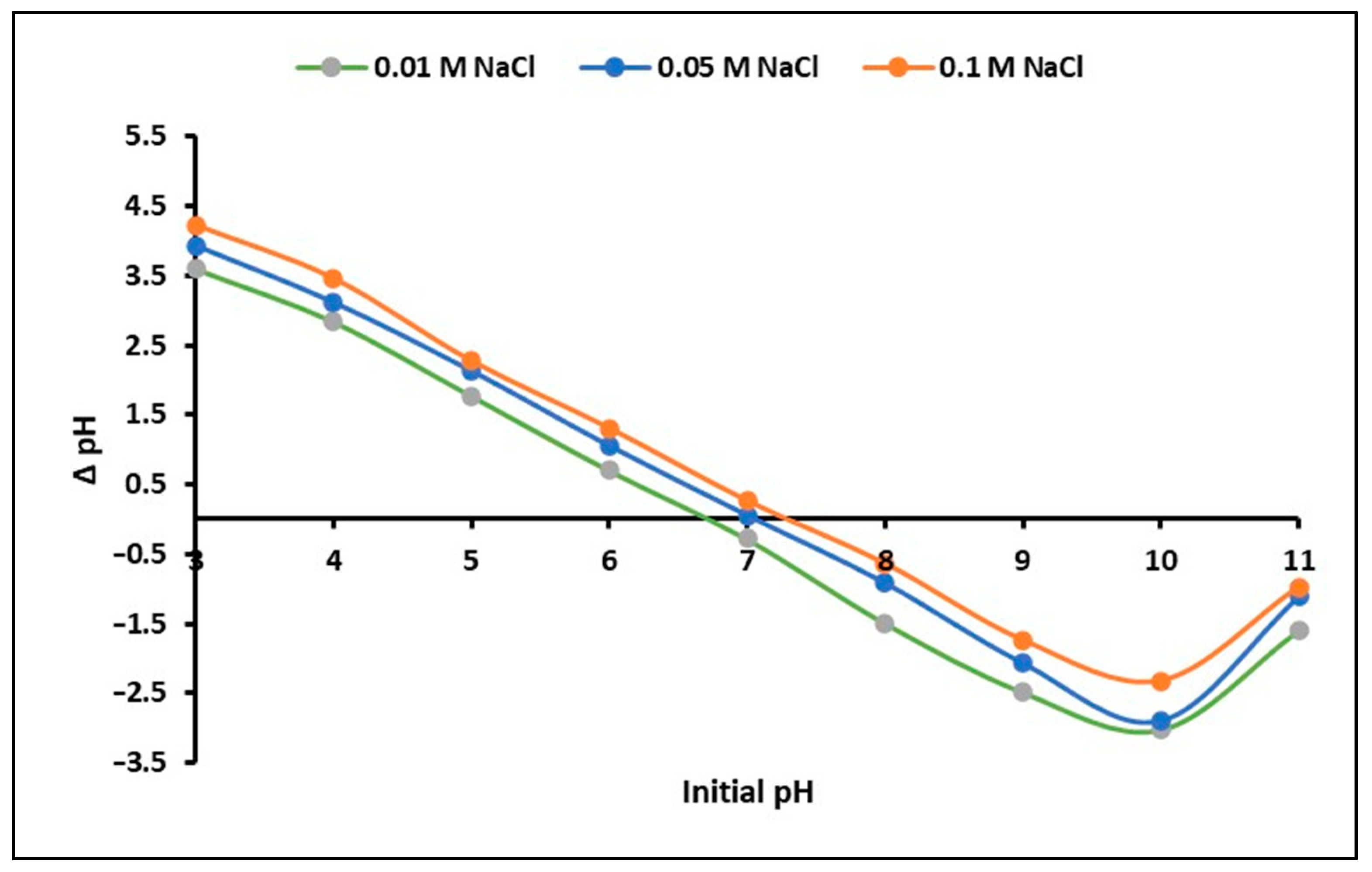

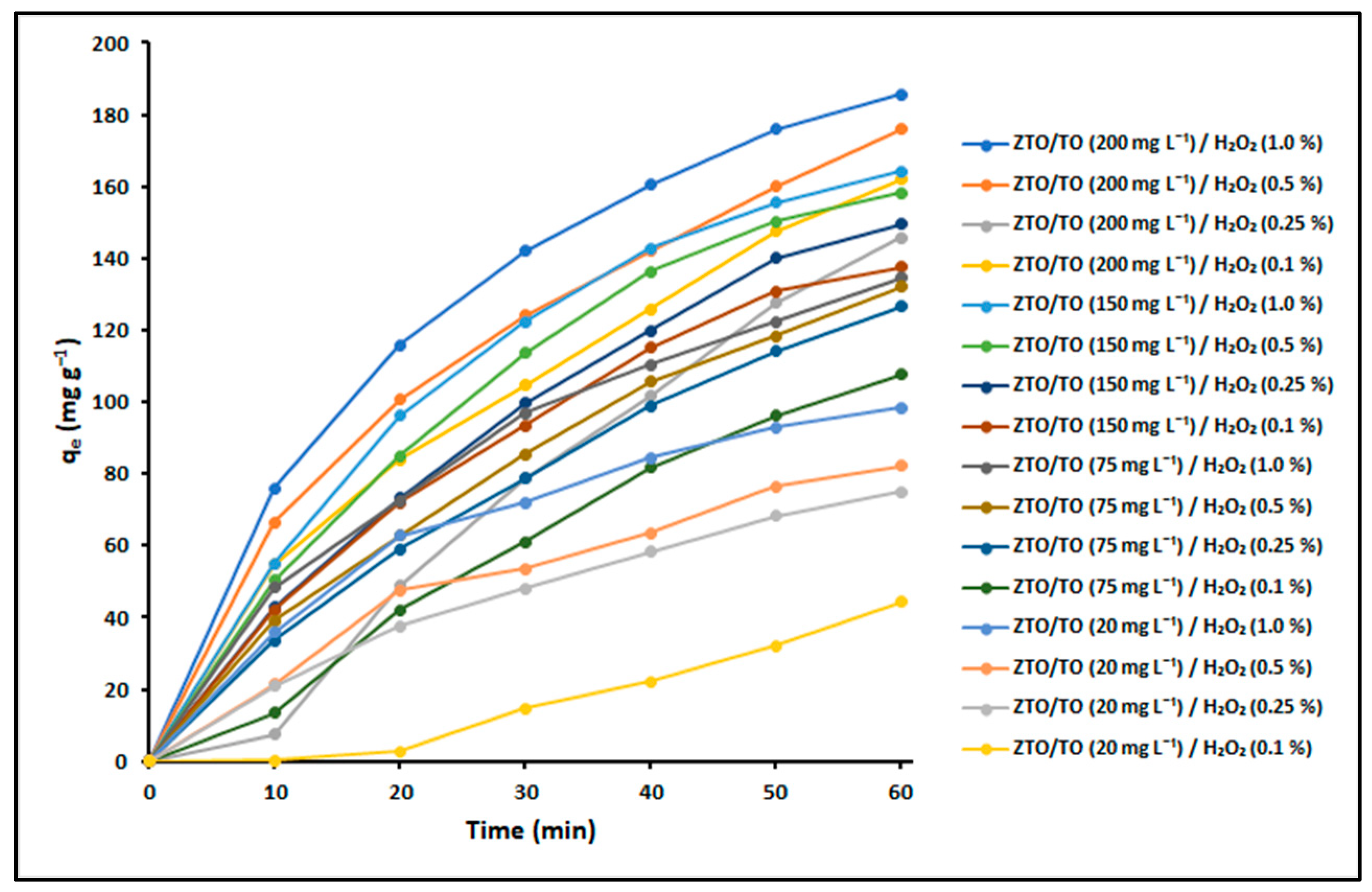
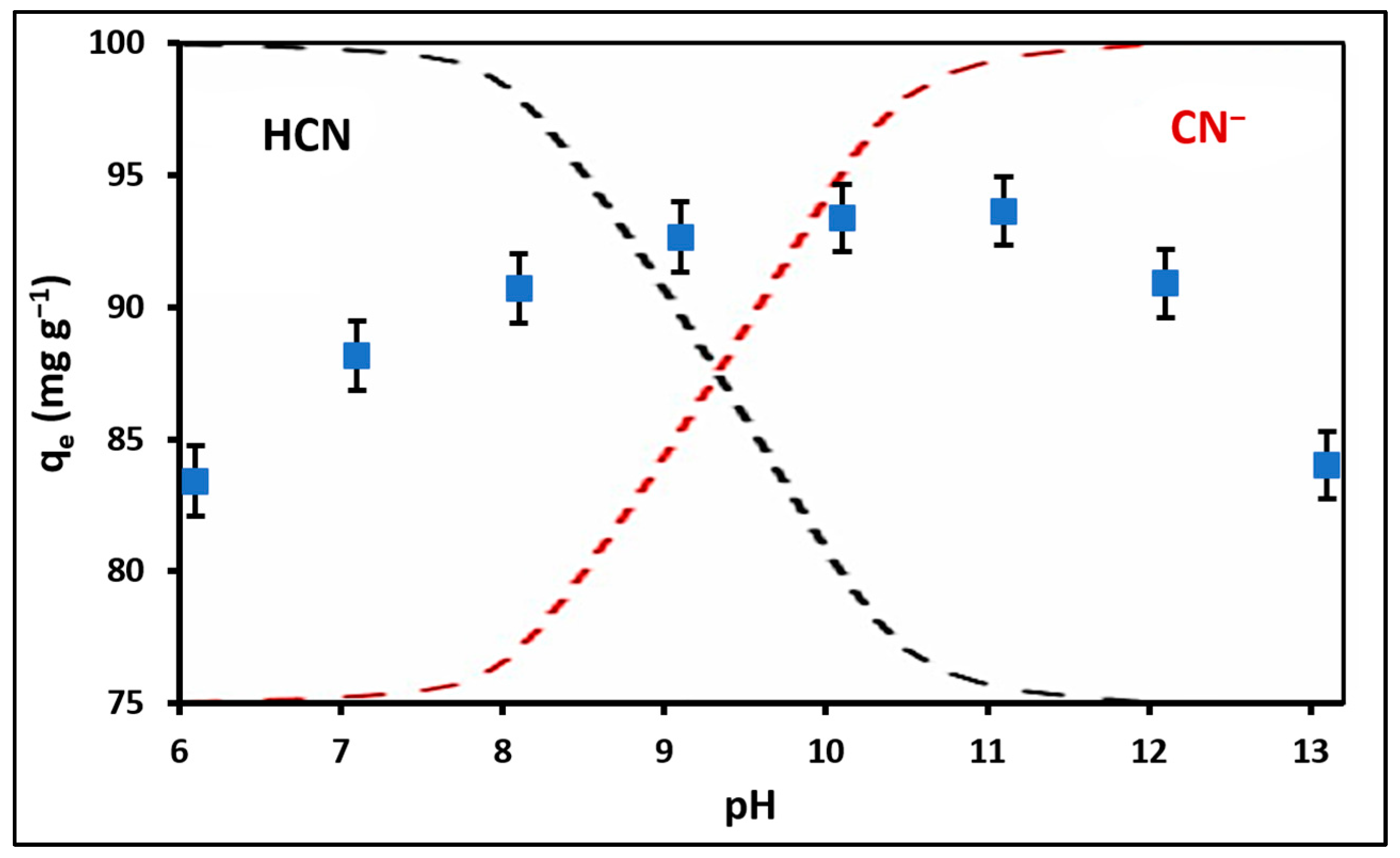
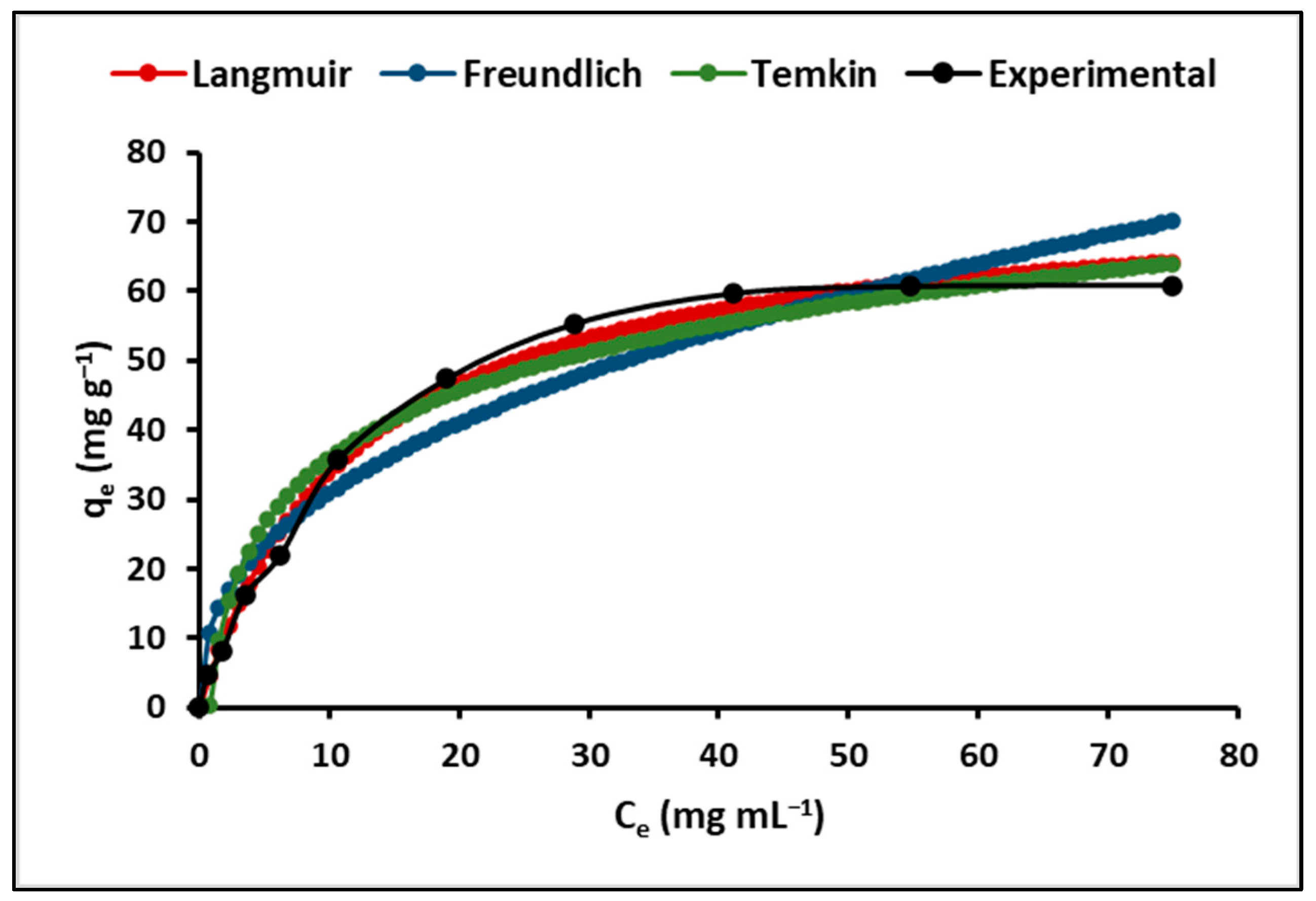
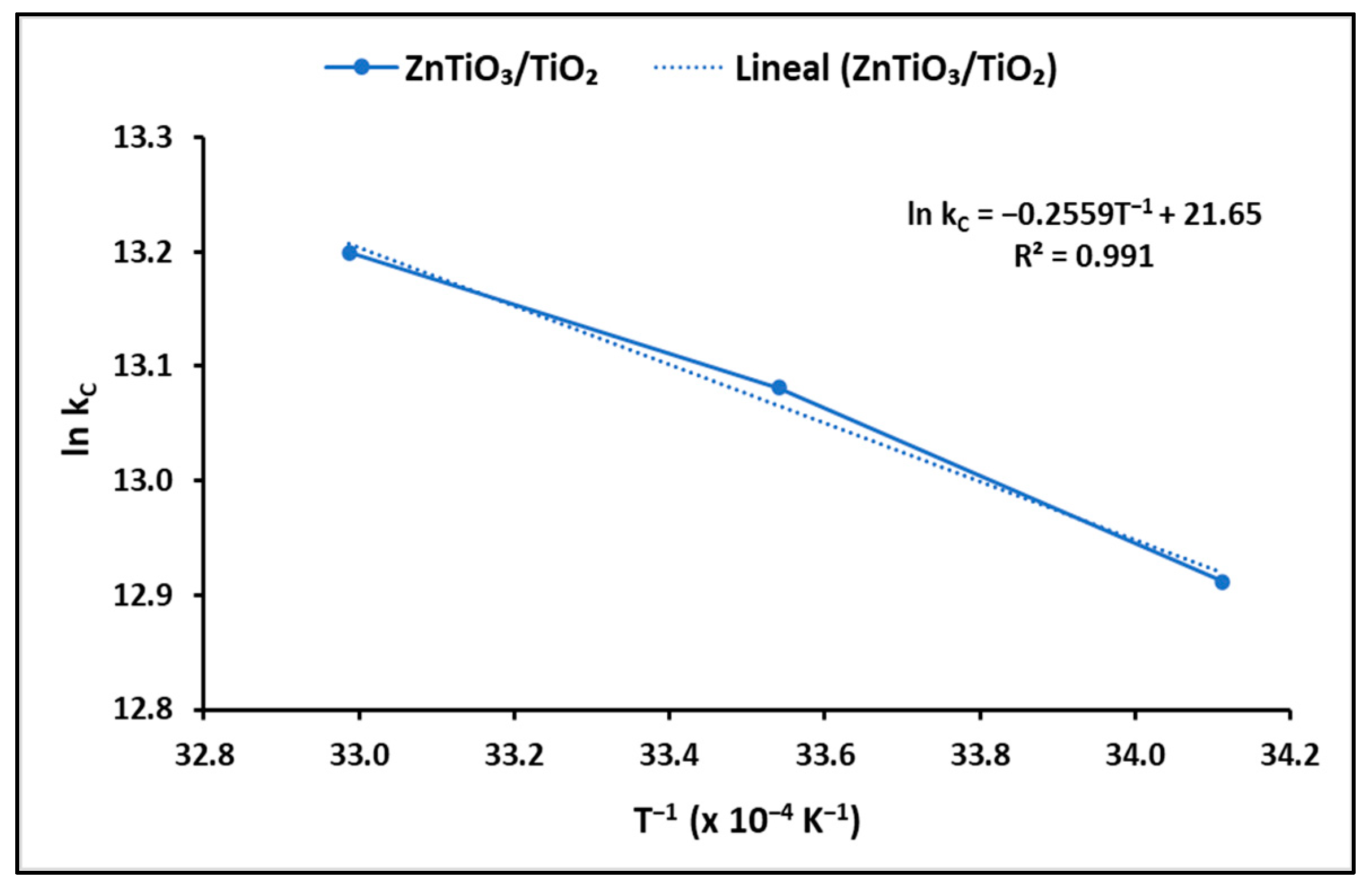
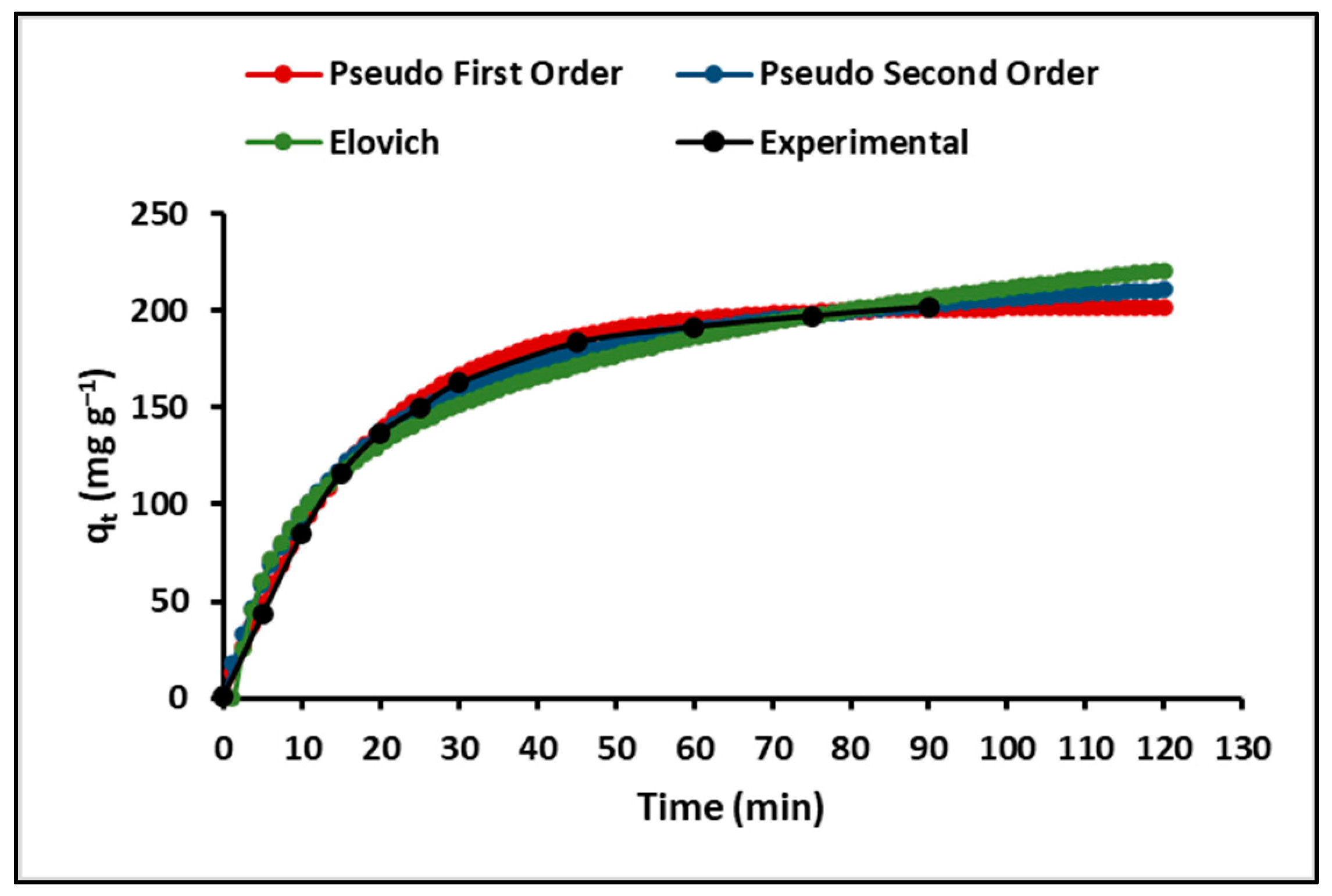

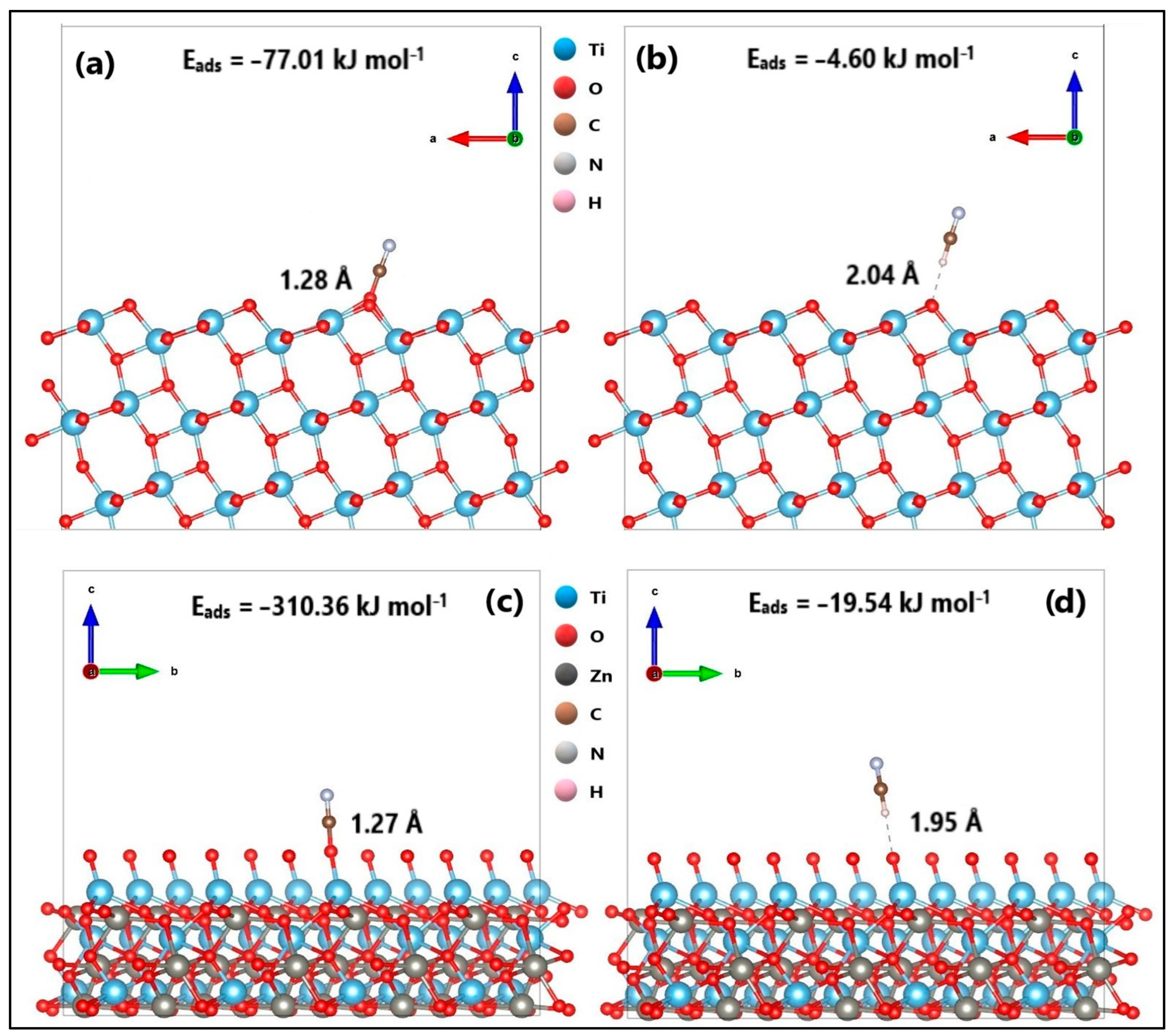

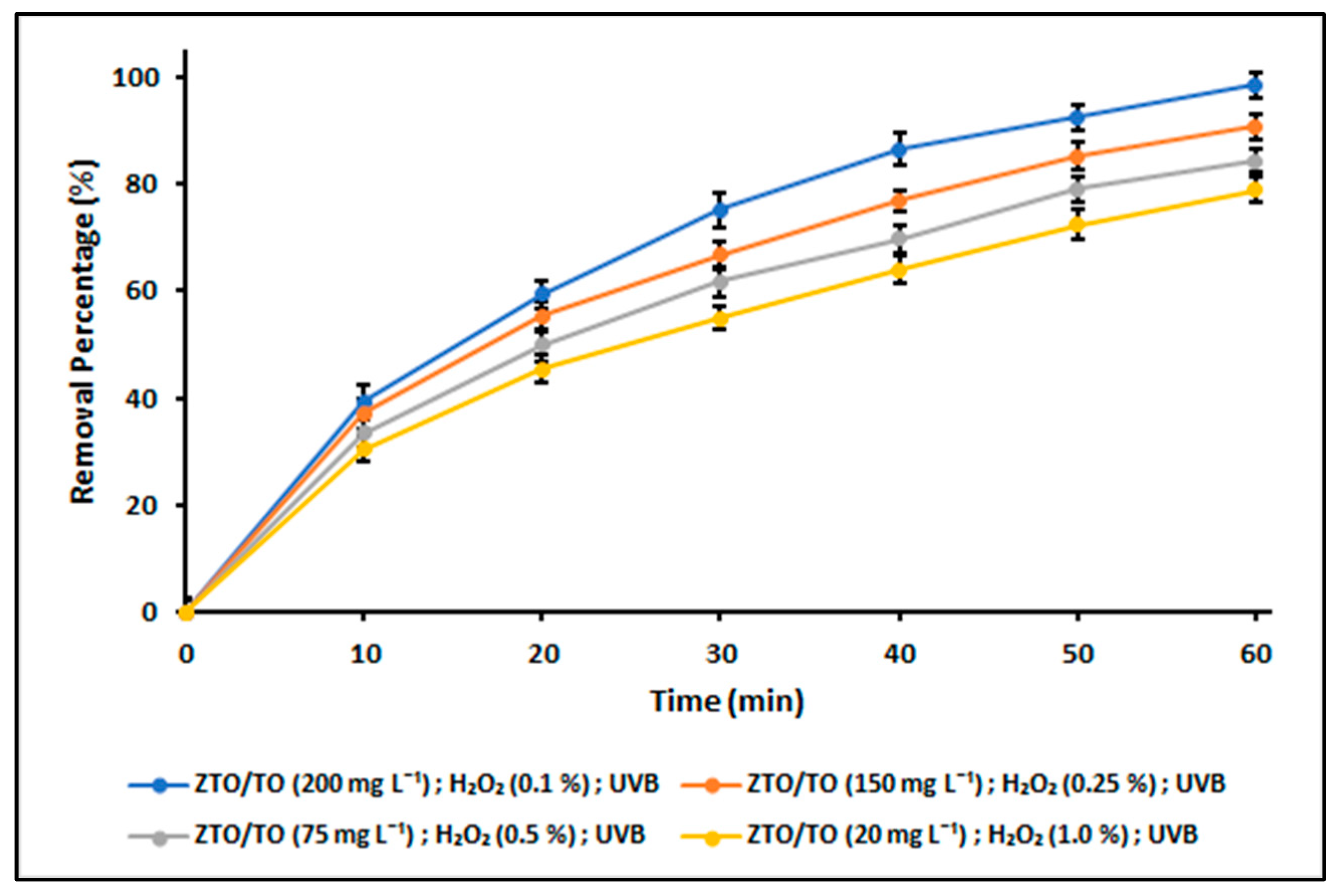

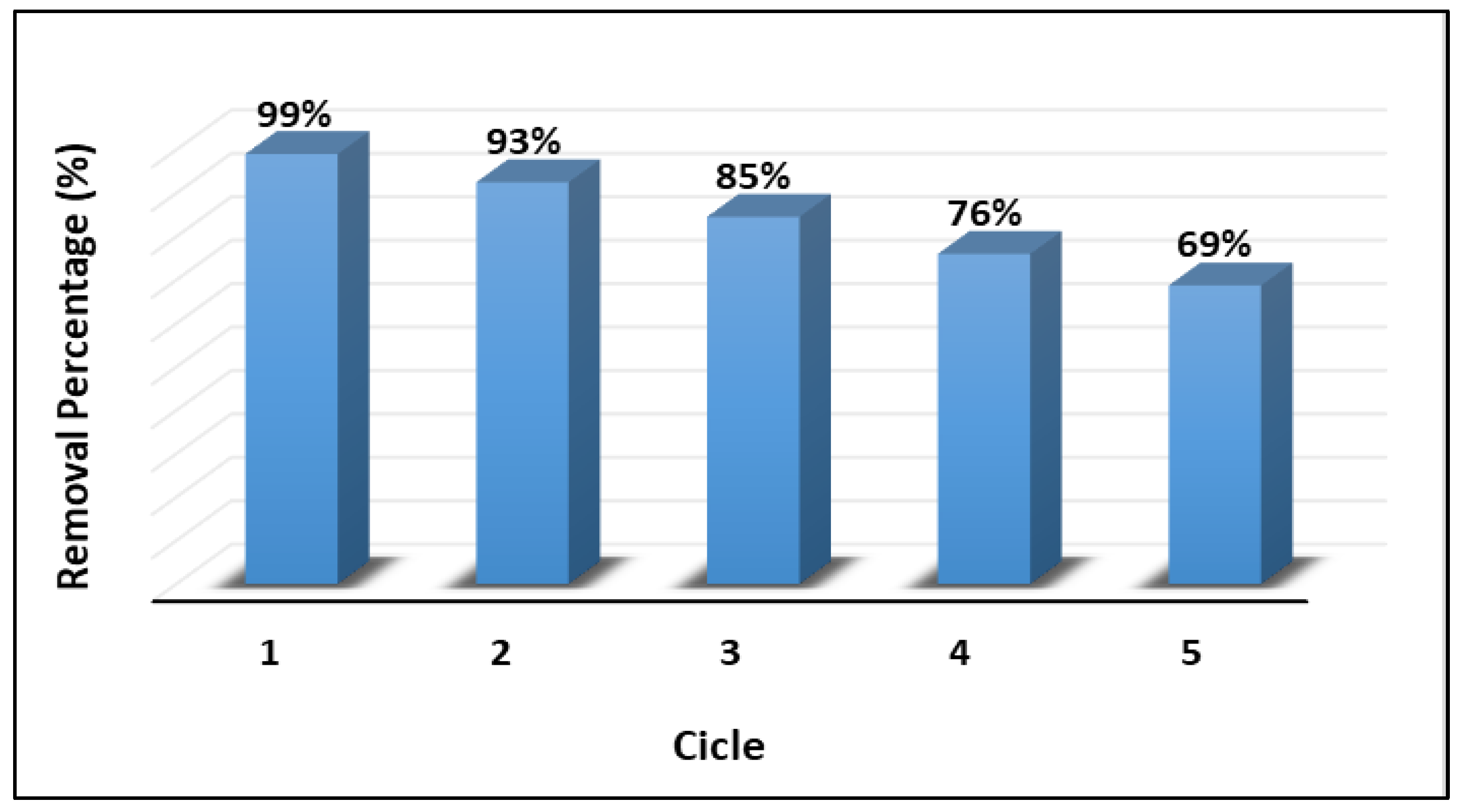
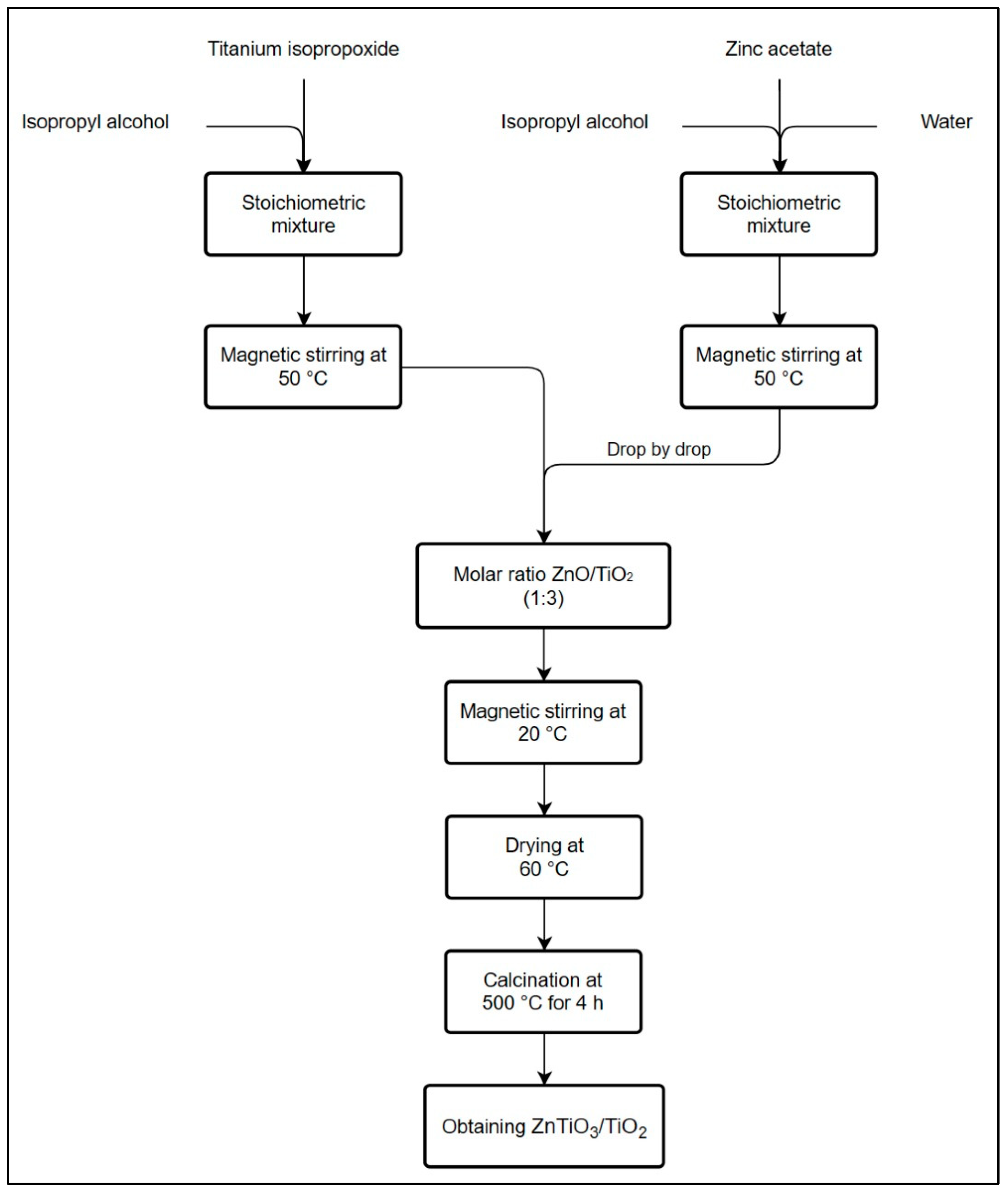
| Denomination | Equation | Parameters | |
|---|---|---|---|
| Scherrer equation | (1) | λ = Wavelength of the X-ray beam (0.15406 nm) K = Shape factor (0.89) θ = Bragg angle β = Full width at half peak height maximum (FWHM) of the X-ray diffraction peak | |
| Adsorbate adsorbed | (2) | C0 = Initial concentration (mg L−1) Ce = Equilibrium concentration (mg L−1) w = Mass of the adsorbent (g) v = Volume of the solution (L) | |
| Langmuir | (3) | qmax = Maximum monolayer adsorption (mg g−1) KL = Equilibrium Langmuir constant related to the adsorption energy (L mg−1) Ce = Concentration of adsorbate in solution at equilibrium (mg L−1) | |
| Freundlich | (4) | KF = Freundlich constant (L mg−1) 1/n = Adsorption intensity constant. Note: For favorable adsorption, the value of n should be between 1 and 10 | |
| Temkin | (5) | qe = Adsorbate adsorbed per unit weight (mg g−1) at equilibrium A = Temkin isotherm constant (L g−1) Ce = Concentration of adsorbate in solution at equilibrium (mg L−1) B = Constant related to the heat adsorption | |
| Constant of heat adsorption | (6) | b = Temkin constant (J mol−1) T = Absolute temperature (K) R = Gas constant (8.314 J mol−1 K−1) | |
| Separation factor | (7) | KL = Equilibrium Langmuir constant related to the adsorption energy (L mg−1) Ce = Concentration of adsorbate in solution at equilibrium (mg L−1) Note: 0 < RL < 1, suitable adsorption, RL > 1 suitable adsorption, RL = 0 irreversible adsorption, RL = 1 linear adsorption. | |
| Gibbs free energy | (8) | ∆G0 = Gibbs free energy (kJ mol−1), ∆H0 = Enthalpy (kJ mol−1) ∆S0 = Entropy (kJ mol−1 K−1) | |
| Van’t Hoff equation | (9) | kC = Dimensionless parameter T = Absolute temperature (K) R = Universal gas constant (8.314 J mol−1 K−1) | |
| (10) | kL = Langmuir constant (L mg−1) Mw = Adsorbate weight (g mol−1) | ||
| Pseudo first order | (11) | k1 = Rate constant (min−1) qe = Adsorbate adsorbed per unit weight (mg g−1) at equilibrium qt = Adsorbate adsorbed per unit weight (mg g−1) at any time (t) | |
| Pseudo second order | (12) | k2 = Rate constant (g mg−1 min−1) qe = Adsorbate adsorbed per unit weight (mg g−1) at equilibrium qt = Adsorbate adsorbed per unit weight (mg g−1) at any time (t) | |
| Elovich | (13) | qt = Adsorbate adsorbed per unit weight (mg g−1) at any time (t) α = Constant related to chemisorption rate β = Constant which depicts the extent of surface coverage | |
| Intraparticle-diffusion | (14) | k3 = Intraparticle diffusion rate constant (mg g−1 min−1/2) A = constant indicating the width of the boundary layer (mg g−1). The larger the value of A, the greater the boundary layer effect. | |
| Particle-diffusion | (15) | qe = Adsorbate adsorbed per unit weight (mg g−1) at equilibrium qt = Adsorbate adsorbed per unit weight (mg g−1) at any time (t) Cz = Ion concentration o the adsorbent (mg kg−1). Dp = Diffusion coefficient in the adsorbent phase (m2 min−1) r = Average radius of the adsorbent particles (1 × 10−7 m) t = Contact time (min) | |
| External-film-diffusion | (16) | qe = Adsorbate adsorbed per unit weight (mg g−1) at equilibrium qt = Adsorbate adsorbed per unit weight (mg g−1) at any time (t) Df = Diffusion in the film phase surrounding the adsorbent particles (m2 min−1) Cs = Ion concentration in the solution (mg L−1) h = Film thickness around the adsorbent particles (10−6 m in poorly stirred solutions) r = Average radius of the adsorbent particles (1 × 10−7 m) t = Contact time (min) | |
| Surface energy | (17) | Eslab = Total energy of the slab material (eV) Ebulk = Total energy of the bulk material (eV) n = Number of atoms involved in the slab A = Surface area (Å2) | |
| Adsorption energy | (18) | Esorb/surf = Energy of the supersystem produced by the adsorbed molecule on the surface (eV) Esurf = Energy of the surface (eV) Esorb = Energy of the isolated molecule in vacuum (eV) | |
| Langmuir-Hinshelwood equation | (19) | k = Actual rate constant (min−1) K = Adsorption constant of the substrate on the nanoparticles C0 = Initial concentration of the substrate (mg L−1) Ct = concentration at a specific time (mg L−1) kapp = apparent rate constant (min−1) |
| Element | TiO2 | ZnTiO3/TiO2 | ||
|---|---|---|---|---|
| Weight % | Atomic % | Weight % | Atomic % | |
| C | 6.15 | 14.36 | 5.42 | 11.90 |
| O | 26.31 | 46.10 | 33.60 | 55.41 |
| Ti | 67.54 | 39.54 | 54.85 | 30.22 |
| Zn | – | – | 6.13 | 2.47 |
| Reaction System Composition | HSD Tukey * | Duncan * | |
|---|---|---|---|
| ZnTiO3/TiO2 (mg L−1) | H2O2 (%) | qe (mg g−1) | qe (mg g−1) |
| 200 | 1.00 | 185.56 ± 2.95 a | 185.56 ± 2.95 a |
| 200 | 0.50 | 176.00 ± 2.18 a,b | 176.00 ± 2.18 b |
| 200 | 0.25 | 145.64 ± 2.46 b,c | 154.64 ± 2.46 c |
| 200 | 0.10 | 162.02 ± 2.62 d,e,f | 162.02 ± 2.62 d,e |
| 150 | 1.00 | 164.08 ± 2.12 b,c | 164.08 ± 2.12 c |
| 150 | 0.50 | 158.24 ± 2.23 c,d | 158.24 ± 2.23 c |
| 150 | 0.25 | 149.47 ± 2.59 c,d,e | 149.47 ± 2.59 d |
| 150 | 0.10 | 137.54 ± 2.31 e,f,g | 137.54 ± 2.31 e,f |
| 75 | 1.00 | 134.62 ± 2.16 e,f,g | 134.62 ± 2.16 f,g |
| 75 | 0.50 | 131.92 ± 2.77 f,g | 131.92 ± 2.77 f,g |
| 75 | 0.25 | 126.52 ± 2.23 g | 126.52 ± 2.23 g |
| 75 | 0.10 | 107.63 ± 2.39 h | 107.63 ± 2.39 h |
| 20 | 1.00 | 98.41 ± 2.31 h | 98.41 ± 2.31 i |
| 20 | 0.50 | 82.22 ± 2.16 i | 82.22 ± 2.16 j |
| 20 | 0.25 | 75.02 ± 2.67 i | 75.02 ± 2.67 j |
| 20 | 0.10 | 44.43 ± 2.47 j | 44.43 ± 2.47 k |
| p-value | <0.001 | <0.001 | |
| Isotherm Parameters | 293.15 K | 298.15 K | 303.15 K | |
|---|---|---|---|---|
| Langmuir | qmax (mg g−1) | 74.49 (±2.42) | 81.94 (±1.52) | 89.39 (±1.52) |
| KL (L mg−1) | 0.27 (±0.01) | 0.32 (±0.04) | 0.36 (±0.03) | |
| RL | 0.16 | 0.14 | 0.36 | |
| χ2 | 2.65 | 3.32 | 2.97 | |
| R2 | 0.99 | 1.00 | 0.98 | |
| Freundlich | KF (L mg−1) | 12.15 (±2.36) | 13.36 (±1.94) | 14.58 (±1.74) |
| n | 2.46 (±0.32) | 2.71 (±0.39) | 2.96 (±0.39) | |
| 1/n | 0.41 | 0.37 | 0.34 | |
| χ2 | 2.89 | 3.21 | 2.45 | |
| R2 | 0.94 | 0.97 | 0.95 | |
| Temkin | B | 13.90 (±1.03) | 15.30 (±1.94) | 16.82 (±1.89) |
| A | 1.32 (±0.30) | 1.46 (±0.39) | 1.60 (±0.35) | |
| χ2 | 2.39 | 3.17 | 2.86 | |
| R2 | 0.96 | 0.98 | 0.96 | |
| Temperature (K) | ln kC | ∆G° (kJ mol−1) | ∆H° (kJ mol−1) | ∆S° (kJ mol−1 K−1) |
|---|---|---|---|---|
| 293.15 | 12.91 | −31.47 | 21.27 | 0.18 |
| 298.15 | 13.08 | −32.43 | ||
| 303.15 | 13.20 | −33.27 |
| Kinetic Parameters | ZTO/TO | |
|---|---|---|
| Pseudo-first-order | qmax (mg g−1) | 201.79 (±1.61) |
| k1 (L mg−1) | 0.06 (±1.60 × 10−3) | |
| χ2 | 6.18 | |
| R2 | 0.98 | |
| Pseudo-second-order | qmax (mg g−1) | 236.64 (±1.81) |
| k2 (L mg−1) | 2.86 × 10−4 (±4.33 × 10−5) | |
| χ2 | 7.41 | |
| R2 | 0.99 | |
| Elovich | α | 34.35 (±7.06) |
| β | 0.02 (±1.74 × 10−3) | |
| χ2 | 6.82 | |
| R2 | 0.95 | |
| Intraparticle diffusion | k3 (mg g−1 min−1/2) | 18.01 (±0.58) |
| A | 39.17 (±1.35) | |
| R2 | 0.84 | |
| External-film diffusion | Df (m2 min−1) | 1.40 × 10−11 |
| R2 | 0.98 | |
| Internal-pore diffusion | Dp (m2 min−1) | 4.60 × 10−17 |
| R2 | 0.92 | |
| Atom | CN | HCN | TiO2 | CN-TiO2 | HCN-TiO2 | ZnTiO3 | CN-ZnTiO3 | HCN-ZnTiO3 |
|---|---|---|---|---|---|---|---|---|
| H1 | - | +0.21 | - | - | +0.24 | - | - | +0.29 |
| C1 | +3.96 | +2.35 | - | +4.00 | +2.37 | - | +4.00 | +2.30 |
| N1 | −3.96 | −2.56 | - | −2.80 | −2.61 | - | −2.77 | −2.60 |
| Ti57 | - | - | +2.54 | +2.35 | +0.02 | - | - | - |
| Ti60 | - | - | +2.56 | +2.48 | +0.00 | - | - | - |
| O59 | - | - | −1.16 | −2.09 | −0.04 | - | - | - |
| Ti23 | - | - | - | - | - | +2.51 | +2.36 | +0.01 |
| O8 | - | - | - | - | - | −1.11 | −2.04 | −1.15 |
| Description | kapp (min−1) |
|---|---|
| ZnTiO3/TiO2 (200 mg L−1)/H2O2 (0.10%) | 0.0738 |
| ZnTiO3/TiO2 (150 mg L−1)/H2O2 (0.25%) | 0.0395 |
| ZnTiO3/TiO2 (75 mg L−1)/H2O2 (0.50%) | 0.0306 |
| ZnTiO3/TiO2 (20 mg L−1)/H2O2 (1.0%) | 0.0246 |
| No. | H2O2 (%) | ZnTiO3/TiO2 (mg L−1) | UVB Light | Removal (%) |
|---|---|---|---|---|
| 1 | 1 | 200 | Absent | 75.46 |
| 2 | 1 | 150 | Absent | 64.71 |
| 3 | 1 | 75 | Absent | 54.40 |
| 4 | 1 | 20 | Absent | 42.71 |
| 5 | 1 | 20 | Present | 78.48 |
| 6 | 0.5 | 200 | Absent | 71.47 |
| 7 | 0.5 | 150 | Absent | 63.93 |
| 8 | 0.5 | 75 | Absent | 53.58 |
| 9 | 0.5 | 20 | Absent | 36.08 |
| 10 | 0.5 | 75 | Present | 85.26 |
| 11 | 0.25 | 200 | Absent | 69.83 |
| 12 | 0.25 | 150 | Absent | 60.99 |
| 13 | 0.25 | 75 | Absent | 51.72 |
| 14 | 0.25 | 20 | Absent | 29.53 |
| 15 | 0.25 | 150 | Present | 92.22 |
| 16 | 0.1 | 200 | Absent | 67.95 |
| 17 | 0.1 | 150 | Absent | 55.56 |
| 18 | 0.1 | 75 | Absent | 44.33 |
| 19 | 0.1 | 20 | Absent | 25.20 |
| 20 | 0.1 | 200 | Present | 99.74 |
| 21 | 0.1 | 0 | Absent | 12.63 |
| 22 | 0 | 20 | Absent | 18.17 |
| 23 | 0 | 0 | Present | 0.00 |
Disclaimer/Publisher’s Note: The statements, opinions and data contained in all publications are solely those of the individual author(s) and contributor(s) and not of MDPI and/or the editor(s). MDPI and/or the editor(s) disclaim responsibility for any injury to people or property resulting from any ideas, methods, instructions or products referred to in the content. |
© 2023 by the authors. Licensee MDPI, Basel, Switzerland. This article is an open access article distributed under the terms and conditions of the Creative Commons Attribution (CC BY) license (https://creativecommons.org/licenses/by/4.0/).
Share and Cite
Jaramillo-Fierro, X.; Ramón, J.; Valarezo, E. Cyanide Removal by ZnTiO3/TiO2/H2O2/UVB System: A Theoretical-Experimental Approach. Int. J. Mol. Sci. 2023, 24, 16446. https://doi.org/10.3390/ijms242216446
Jaramillo-Fierro X, Ramón J, Valarezo E. Cyanide Removal by ZnTiO3/TiO2/H2O2/UVB System: A Theoretical-Experimental Approach. International Journal of Molecular Sciences. 2023; 24(22):16446. https://doi.org/10.3390/ijms242216446
Chicago/Turabian StyleJaramillo-Fierro, Ximena, John Ramón, and Eduardo Valarezo. 2023. "Cyanide Removal by ZnTiO3/TiO2/H2O2/UVB System: A Theoretical-Experimental Approach" International Journal of Molecular Sciences 24, no. 22: 16446. https://doi.org/10.3390/ijms242216446
APA StyleJaramillo-Fierro, X., Ramón, J., & Valarezo, E. (2023). Cyanide Removal by ZnTiO3/TiO2/H2O2/UVB System: A Theoretical-Experimental Approach. International Journal of Molecular Sciences, 24(22), 16446. https://doi.org/10.3390/ijms242216446








